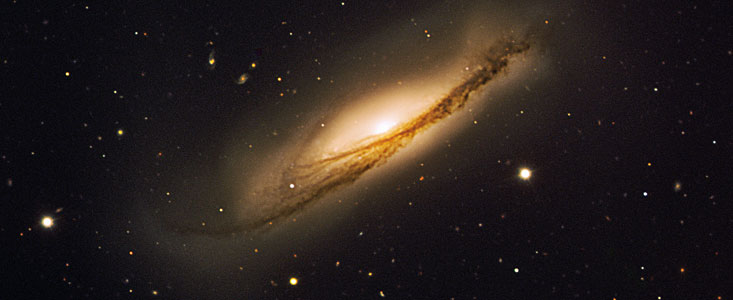Press Release
Twin Explosions In Gigantic Dusty Potato Crisp
11 May 2006
ESO's Very Large Telescope, equipped with the multi-mode FORS instrument, took an image of NGC 3190, a galaxy so distorted that astronomers gave it two names. And as if to prove them right, in 2002 it fired off, almost simultaneously, two stellar explosions, a very rare event.
This beautiful edge-on spiral galaxy with tightly wound arms and a warped shape that makes it resemble a gigantic potato crisp lies in the constellation Leo ('the Lion') [1] and is approximately 70 million light years away. It is the dominant member of a small group of galaxies known as Hickson 44, named after the Canadian astronomer, Paul Hickson. In addition to NGC 3190 [2], Hickson 44 consists of one elliptical and two spiral galaxies. These are, however, slightly out of the field of view and therefore not visible here.
In 1982, Hickson published a catalogue of over 400 galaxies found in compact, physically-related groups of typically 4 to 5 galaxies per group. Such compact groups allow astronomers to study how galaxies dynamically affect each other, and help them test current ideas on how galaxies form. One idea is that compact groups of galaxies, such as Hickson 44, merge to form a giant elliptical galaxy, such as NGC 1316.
Indeed, signs of tidal interactions are visible in the twisted dust lane of NGC 3190. This distortion initially misled astronomers into assigning a separate name for the southwestern side, NGC 3189, although NGC 3190 is the favoured designation.
NGC 3190 has an 'Active Galactic Nucleus', and as such, the bright, compact nucleus is thought to host a supermassive black hole.
In March 2002, a new supernova (SN 2002bo) was found in between the 'V' of the dust lanes in the southeastern part of NGC 3190. It was discovered independently by the Brazilian and Japanese amateur astronomers, Paulo Cacella and Yoji Hirose. SN 2002bo was caught almost two weeks before reaching its maximum brightness, allowing astronomers to study its evolution. It has been the subject of intense monitoring by a world-wide network of telescopes. The conclusion was that SN 2002bo is a rather unusual Type Ia supernova [3]. The image presented here was taken in March 2003, i.e. about a year after the maximum of the supernova which is 50 times fainter on the image than a year before.
While observing SN 2002bo in May 2002, a group of Italian astronomers discovered another supernova, SN 2002cv, on the other side of NGC 3190. Two supernovae of this type appearing nearly simultaneously in the same galaxy is a rare event, as normally astronomers expect only one such event per century in a galaxy. SN 2002cv was best visible at infrared wavelengths as it was superimposed on the dust lane of NGC 3190, and therefore hidden by a large quantity of dust. In fact, this supernova holds the record for the most obscured Type Ia event.
The image was obtained with a total exposure time of 14 minutes only. Yet, with the amazing power of the Very Large Telescope, it reveals a large zoo of galaxies of varying morphologies. How many can you find?
A high resolution image and its caption is available on this page.
Notes
[1] The constellation 'Leo' represents the Lion. Many ancient civilisations, e.g. Sumerian, Babylonian, Persian, Syrian, Greek, all identified this constellation as a lion. In Greek Mythology, the first of Hercules' twelve tasks was to slay the Nemean lion and bring back its skin.
[2] 'NGC' stands for 'New General Catalogue' (of nebulae and clusters) that was published in 1888 by J.L.E. Dreyer in the 'Memoirs of the Royal Astronomical Society'.
[3] Type Ia supernovae are believed to result from the explosion of old stars known as 'white dwarfs' - the endpoint of most low mass stars such as our Sun. However, a white dwarf only explodes when its mass reaches a certain critical value (about 1.4 times the mass of our Sun). The general consensus is that this critical mass can only be attained if the white dwarf has a nearby companion star from which it can gain matter. Their generally uniform properties combined with their intrinsic brightness means that Type Ia supernovae can be used to measure relative distances (see eso9861). They have been used to infer that the Universe is currently accelerating.
SN 2002bo has been extensively studied by Benetti et al. (2004, MNRAS, 348, 261), while SN 2002cv has been described by Di Paola et al. (2002, A&A, 393, L21).
More information
Technical Information: Image is based on data extracted from the ESO Science Archive. It is a colour composite based on images obtained on 26 March 2003 with FORS1 on UT2 (Kueyen) in four filters (B, V, R and I) for a total exposure time of 14 minutes. The observations were done in the framework of a programme aiming at studying the physics of Type Ia supernovae. The field of view is 6.15 x 5 arcminutes. North is up and East is to the left. The data extraction from the archive, data reduction and final colour processing of the image was done by Henri Boffin (ESO).
About the Release
| Release No.: | eso0617 |
| Legacy ID: | PR 17/06 |
| Name: | NGC 3190 |
| Type: | Local Universe : Galaxy : Type : Spiral |
| Facility: | Very Large Telescope |
| Instruments: | FORS1 |

